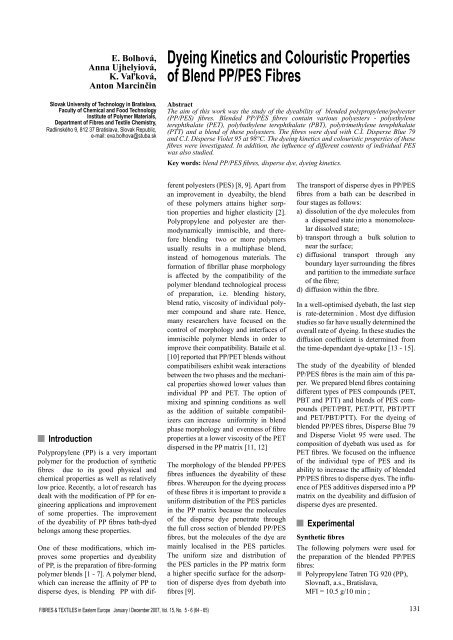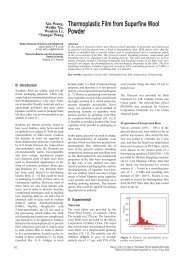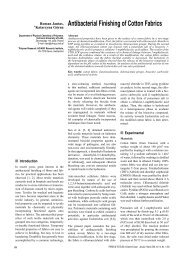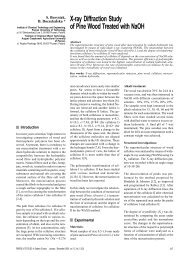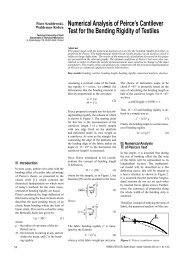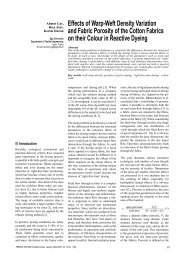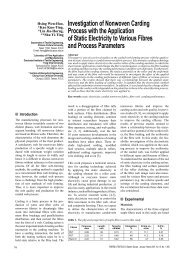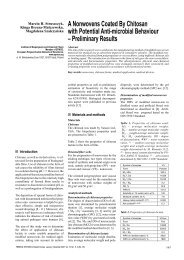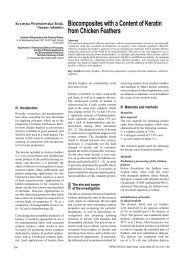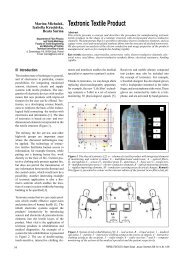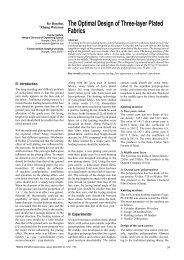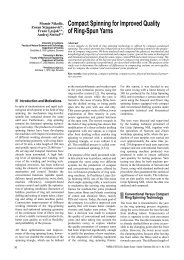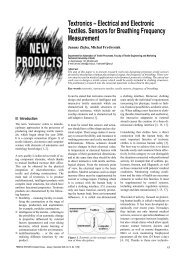Dyeing Kinetics and Colouristic Properties of Blend PP/PES Fibres
Dyeing Kinetics and Colouristic Properties of Blend PP/PES Fibres
Dyeing Kinetics and Colouristic Properties of Blend PP/PES Fibres
You also want an ePaper? Increase the reach of your titles
YUMPU automatically turns print PDFs into web optimized ePapers that Google loves.
n Introduction<br />
E. Bolhová,<br />
Anna Ujhelyiová,<br />
K. Vaľková,<br />
Anton Marcinčin<br />
Slovak University <strong>of</strong> Technology in Bratislava,<br />
Faculty <strong>of</strong> Chemical <strong>and</strong> Food Technology<br />
Institute <strong>of</strong> Polymer Materials,<br />
Department <strong>of</strong> <strong>Fibres</strong> <strong>and</strong> Textile Chemistry,<br />
Radlinského 9, 812 37 Bratislava, Slovak Republic,<br />
e-mail: eva.bolhova@stuba.sk<br />
Polypropylene (<strong>PP</strong>) is a very important<br />
polymer for the production <strong>of</strong> synthetic<br />
fibres due to its good physical <strong>and</strong><br />
chemical properties as well as relatively<br />
low price. Recently, a lot <strong>of</strong> research has<br />
dealt with the modification <strong>of</strong> <strong>PP</strong> for engineering<br />
applications <strong>and</strong> improvement<br />
<strong>of</strong> some properties. The improvement<br />
<strong>of</strong> the dyeability <strong>of</strong> <strong>PP</strong> fibres bath-dyed<br />
belongs among these properties.<br />
One <strong>of</strong> these modifications, which improves<br />
some properties <strong>and</strong> dyeability<br />
<strong>of</strong> <strong>PP</strong>, is the preparation <strong>of</strong> fibre-forming<br />
polymer blends [1 - 7]. A polymer blend,<br />
which can increase the affinity <strong>of</strong> <strong>PP</strong> to<br />
disperse dyes, is blending <strong>PP</strong> with dif-<br />
FIBRES & TEXTILES in Eastern Europe January / December 2007, Vol. 15, No. 5 - 6 (64 - 65)<br />
<strong>Dyeing</strong> <strong>Kinetics</strong> <strong>and</strong> <strong>Colouristic</strong> <strong>Properties</strong><br />
<strong>of</strong> <strong>Blend</strong> <strong>PP</strong>/<strong>PES</strong> <strong>Fibres</strong><br />
Abstract<br />
The aim <strong>of</strong> this work was the study <strong>of</strong> the dyeability <strong>of</strong> blended polypropylene/polyester<br />
(<strong>PP</strong>/<strong>PES</strong>) fibres. <strong>Blend</strong>ed <strong>PP</strong>/<strong>PES</strong> fibres contain various polyesters - polyethylene<br />
terephthalate (PET), polybuthylene terephthalate (PBT), polytrimethylene terephthalate<br />
(PTT) <strong>and</strong> a blend <strong>of</strong> these polyesters. The fibres were dyed with C.I. Disperse Blue 79<br />
<strong>and</strong> C.I. Disperse Violet 95 at 98°C. The dyeing kinetics <strong>and</strong> colouristic properties <strong>of</strong> these<br />
fibres were investigated. In addition, the influence <strong>of</strong> different contents <strong>of</strong> individual <strong>PES</strong><br />
was also studied.<br />
Key words: blend <strong>PP</strong>/<strong>PES</strong> fibres, disperse dye, dyeing kinetics.<br />
ferent polyesters (<strong>PES</strong>) [8, 9]. Apart from<br />
an improvement in dyeabilty, the blend<br />
<strong>of</strong> these polymers attains higher sorption<br />
properties <strong>and</strong> higher elasticity [2].<br />
Polypropylene <strong>and</strong> polyester are thermodynamically<br />
immiscible, <strong>and</strong> therefore<br />
blending two or more polymers<br />
usually results in a multiphase blend,<br />
instead <strong>of</strong> homogenous materials. The<br />
formation <strong>of</strong> fibrillar phase morphology<br />
is affected by the compatibility <strong>of</strong> the<br />
polymer blend<strong>and</strong> technological process<br />
<strong>of</strong> preparation, i.e. blending history,<br />
blend ratio, viscosity <strong>of</strong> individual polymer<br />
compound <strong>and</strong> share rate. Hence,<br />
many researchers have focused on the<br />
control <strong>of</strong> morphology <strong>and</strong> interfaces <strong>of</strong><br />
immiscible polymer blends in order to<br />
improve their compatibility. Bataile et al.<br />
[10] reported that <strong>PP</strong>/PET blends without<br />
compatibilisers exhibit weak interactions<br />
between the two phases <strong>and</strong> the mechanical<br />
properties showed lower values than<br />
individual <strong>PP</strong> <strong>and</strong> PET. The option <strong>of</strong><br />
mixing <strong>and</strong> spinning conditions as well<br />
as the addition <strong>of</strong> suitable compatibilizers<br />
can increase uniformity in blend<br />
phase morphology <strong>and</strong> evenness <strong>of</strong> fibre<br />
properties at a lower viscosity <strong>of</strong> the PET<br />
dispersed in the <strong>PP</strong> matrix [11, 12]<br />
The morphology <strong>of</strong> the blended <strong>PP</strong>/<strong>PES</strong><br />
fibres influences the dyeability <strong>of</strong> these<br />
fibres. Whereupon for the dyeing process<br />
<strong>of</strong> these fibres it is important to provide a<br />
uniform distribution <strong>of</strong> the <strong>PES</strong> particles<br />
in the <strong>PP</strong> matrix because the molecules<br />
<strong>of</strong> the disperse dye penetrate through<br />
the full cross section <strong>of</strong> blended <strong>PP</strong>/<strong>PES</strong><br />
fibres, but the molecules <strong>of</strong> the dye are<br />
mainly localised in the <strong>PES</strong> particles.<br />
The uniform size <strong>and</strong> distribution <strong>of</strong><br />
the <strong>PES</strong> particles in the <strong>PP</strong> matrix form<br />
a higher specific surface for the adsorption<br />
<strong>of</strong> disperse dyes from dyebath into<br />
fibres [9].<br />
The transport <strong>of</strong> disperse dyes in <strong>PP</strong>/<strong>PES</strong><br />
fibres from a bath can be described in<br />
four stages as follows:<br />
a) dissolution <strong>of</strong> the dye molecules from<br />
a dispersed state into a monomolecular<br />
dissolved state;<br />
b) transport through a bulk solution to<br />
near the surface;<br />
c) diffusional transport through any<br />
boundary layer surrounding the fibres<br />
<strong>and</strong> partition to the immediate surface<br />
<strong>of</strong> the fibre;<br />
d) diffusion within the fibre.<br />
In a well-optimised dyebath, the last step<br />
is rate-determinion . Most dye diffusion<br />
studies so far have usually determined the<br />
overall rate <strong>of</strong> dyeing. In these studies the<br />
diffusion coefficient is determined from<br />
the time-dependant dye-uptake [13 - 15].<br />
The study <strong>of</strong> the dyeability <strong>of</strong> blended<br />
<strong>PP</strong>/<strong>PES</strong> fibres is the main aim <strong>of</strong> this paper.<br />
We prepared blend fibres containing<br />
different types <strong>of</strong> <strong>PES</strong> compounds (PET,<br />
PBT <strong>and</strong> PTT) <strong>and</strong> blends <strong>of</strong> <strong>PES</strong> compounds<br />
(PET/PBT, PET/PTT, PBT/PTT<br />
<strong>and</strong> PET/PBT/PTT). For the dyeing <strong>of</strong><br />
blended <strong>PP</strong>/<strong>PES</strong> fibres, Disperse Blue 79<br />
<strong>and</strong> Disperse Violet 95 were used. The<br />
composition <strong>of</strong> dyebath was used as for<br />
PET fibres. We focused on the influence<br />
<strong>of</strong> the individual type <strong>of</strong> <strong>PES</strong> <strong>and</strong> its<br />
ability to increase the affinity <strong>of</strong> blended<br />
<strong>PP</strong>/<strong>PES</strong> fibres to disperse dyes. The influence<br />
<strong>of</strong> <strong>PES</strong> additives dispersed into a <strong>PP</strong><br />
matrix on the dyeability <strong>and</strong> diffusion <strong>of</strong><br />
disperse dyes are presented.<br />
n Experimental<br />
Synthetic fibres<br />
The following polymers were used for<br />
the preparation <strong>of</strong> the blended <strong>PP</strong>/<strong>PES</strong><br />
fibres:<br />
n Polypropylene Tatren TG 920 (<strong>PP</strong>),<br />
Slovnaft, a.s., Bratislava,<br />
MFI = 10.5 g/10 min ;<br />
131
Table 1. Composition <strong>of</strong> the blend <strong>PP</strong>/<strong>PES</strong> fibres.<br />
n Polyethylene terephthalate PET<br />
(PET), Slovenský Hodváb, a. s.,<br />
Senica, IV = 0.5 l.g-1 ;<br />
n Polybuthylene Terephthalate Celanex<br />
N 2000 (PBT), Ticona Engineering<br />
Polymer, MFI =19.8 g/10 min;<br />
n Poly(trimethylene terephthalate)<br />
(PTT) - Du Pont Co - η(γ =100 s-1) =<br />
260 Pa.s;<br />
n Licowax E (LiE) – polyester (montane)<br />
wax, Ciba Specialty Ltd.<br />
The blended <strong>PP</strong>/<strong>PES</strong> fibres was prepared<br />
in two steps - preparation <strong>of</strong> the<br />
<strong>PES</strong> concentrates <strong>and</strong> preparation <strong>of</strong> the<br />
blended <strong>PP</strong>/<strong>PES</strong> fibres. The composition<br />
<strong>of</strong> blended <strong>PP</strong>/<strong>PES</strong> fibres is in Table 1.<br />
Disperse dyes<br />
n C.I. Disperse Blue 79<br />
n C.I. Disperse Violet 95<br />
<strong>Dyeing</strong><br />
<strong>Dyeing</strong> conditions<br />
In order to remove the lubricants, the<br />
fibres were washed in a bath <strong>of</strong> 1.5 g.l-1<br />
Slovapon <strong>and</strong> 1 g.l-1 Na3PO4 at 75°C for<br />
20 min.<br />
The fibres were dyed using a laboratory<br />
dyeing machine - Ahiba ↑↓ AG CH 4127<br />
Birsfelden (Switzerl<strong>and</strong>). The following<br />
bath composition was used: dispersant 1<br />
g.l -1 Kortamol NNO, 2 g.l -1 (NH4)2SO4,<br />
132<br />
Types <strong>of</strong> fibres<br />
Contents <strong>of</strong> individual compound in the blended <strong>PP</strong>/<strong>PES</strong> fibres, %<br />
<strong>PP</strong> TG 920 PET PBT PTT Licowax E<br />
PET A - 100 - - 0.12<br />
<strong>PP</strong>/PET B 94.34 5.54 0.12<br />
<strong>PP</strong>/PBT C 94.34 5.54 0.12<br />
<strong>PP</strong>/PTT D 94.34 5.54 0.12<br />
<strong>PP</strong>/PET/PBT E 94.36 1.64 3.88 0.12<br />
<strong>PP</strong>/PET/PTT F 94.36 1.64 3.88 0.12<br />
<strong>PP</strong>/PBT/PTT G 94.36 3.88 1.64 0.12<br />
<strong>PP</strong>/PET/PBT/PTT H 94.40 1.88 1.8 1.8 0.12<br />
a) b)<br />
Figure 1. The dependencies <strong>of</strong> K/S on the type <strong>of</strong> blended <strong>PP</strong>/<strong>PES</strong> fibres dyed with Disperse<br />
Blue 79 (a) <strong>and</strong> Disperse Violet 95 (b) at 98 °C. Remark: A, ... H as in Table 1.<br />
0.17 g.l-1 Texavin <strong>and</strong> disperse dye<br />
1% o.w.f. The fibres were dyed at 98°C.<br />
Reduction clearing<br />
The dyed fibres were washed in a solution<br />
consisting 3 ml.l-1 NaOH 38°Be,<br />
1.5 g.l -1 Slovapon <strong>and</strong> 2 g.l -1 Na2S2O4, at<br />
75°C for 20 minutes.<br />
n Methods <strong>of</strong> analysis<br />
The kinetics <strong>of</strong> the disperse dyes exhaustion<br />
from bath into the PET <strong>and</strong> <strong>PP</strong>/<strong>PES</strong><br />
fibres was evaluated upon an increase<br />
(decrease) <strong>of</strong> dye concentration in the<br />
fibres (in bath) during the dyeing process.<br />
The dyeing process <strong>of</strong> the? blended<br />
<strong>PP</strong>/<strong>PES</strong> fibres was finished at time intervals<br />
3, 5, 10, 15, 20, 25, 30, 50, 70<br />
<strong>and</strong> 90 min. The quantity <strong>of</strong> exhausted<br />
dye on the fibre was estimated from the<br />
absorption <strong>of</strong> dye solution measured at<br />
its λ max <strong>and</strong> from the calibration curve.<br />
The dependence <strong>of</strong> the exhaustion <strong>of</strong> dye<br />
on time was used for the calculation <strong>of</strong><br />
the dyeing rate constant (K) <strong>and</strong> diffusion<br />
coefficient (D). The dyeing rate was determined<br />
from Vickerstaff’s hyperbolic<br />
equation [16, 17] (1):<br />
c t = K . t . c ∞ 2/(K . t . c ∞ + 1) (1)<br />
Diffusion coefficients D were obtained<br />
from Hill’s empirical equation [13, 18,<br />
19]. The principle <strong>of</strong> calculation for the<br />
apparent diffusion coefficient from Hill’s<br />
equation is the assumption <strong>of</strong> the identity<br />
<strong>of</strong> the half-dyeing time t1/2 (t1/2 is the<br />
time required for a fibre absorbing half<br />
the quantity <strong>of</strong> dye absorbed in a state <strong>of</strong><br />
equilibrium) <strong>and</strong> half-time diffusion. The<br />
diffusion coefficient was calculated from<br />
the equation (2):<br />
D Hill = 6.324×10-2. K . c∞ . r2 (2)<br />
where:<br />
r - radius <strong>of</strong> fibre, m<br />
D - diffusion coefficient, m2. s-1<br />
K - dyeing rate constant from Vickerstaff’s<br />
equation, s -1<br />
ct - concentration <strong>of</strong> dye in fibre in the<br />
time t, mg . g-1<br />
c ∝ - concentration <strong>of</strong> dye at the moment<br />
<strong>of</strong> state <strong>of</strong> equilibrium (mg . g-1).<br />
n Results <strong>and</strong> discussion<br />
Dyeability <strong>of</strong> blended <strong>PP</strong>/<strong>PES</strong> fibres<br />
The blended <strong>PP</strong>/<strong>PES</strong> fibres, which contained<br />
5.54 wt. % <strong>of</strong> PET, PBT, PTT<br />
<strong>and</strong> blends <strong>of</strong> these polyesters, were<br />
dyed from bath at a temperature <strong>of</strong><br />
98 °C with C.I. Disperse Blue 79 <strong>and</strong><br />
C.I. Disperse Violet 95. The dyeability<br />
<strong>of</strong> the blended <strong>PP</strong>/<strong>PES</strong> fibres was<br />
evaluated on the basis <strong>of</strong> colour strength<br />
(K/S). The dependences <strong>of</strong> K/S on the<br />
composition <strong>of</strong> the blended <strong>PP</strong>/<strong>PES</strong><br />
fibres are shown in the Figure 1 a-b.<br />
The results show that the affinity <strong>of</strong> disperse<br />
dyes to the blended <strong>PP</strong>/<strong>PES</strong> fibres<br />
is affected by the content <strong>and</strong> type <strong>of</strong> <strong>PES</strong><br />
additive dispersed in the <strong>PP</strong> matrix.<br />
The highest value <strong>of</strong> K/S was reached in<br />
the blended <strong>PP</strong>/<strong>PES</strong> fibres, which contained<br />
5.54 wt.% <strong>of</strong> PET <strong>and</strong> was dyed<br />
with C.I. Disperse Blue 79. The K/S <strong>of</strong><br />
the blended <strong>PP</strong>/PBT/LiE <strong>and</strong> <strong>PP</strong>/PTT/<br />
LiE fibres reached about 23 - 25% lower<br />
values <strong>of</strong> K/S than PET fibres. PET <strong>and</strong><br />
PTT dispersed in the <strong>PP</strong> matrix appeared<br />
to be an optimal blend <strong>of</strong> polyesters<br />
(Figure 1.a, blended <strong>PP</strong>/PET/PTT/LiE<br />
fibre). The value <strong>of</strong> K/S for this fibre<br />
reached similar K/S to that <strong>of</strong> the PET<br />
<strong>and</strong> <strong>PP</strong>/PET/LiE fibres <strong>and</strong> the K/S<br />
was about 20% higher than the K/S <strong>of</strong><br />
blended <strong>PP</strong>/PTT/LiE fibre. The positive<br />
influence <strong>of</strong> PTT on the dyeability <strong>of</strong><br />
blended <strong>PP</strong>/PET/PTT fibre can be caused<br />
by the suppression <strong>of</strong> crystallinity <strong>and</strong> an<br />
increase in their deformation ability in<br />
comparison with PET <strong>and</strong> PBT. It can<br />
improve the sorption <strong>of</strong> dye into blended<br />
<strong>PP</strong>/<strong>PES</strong> fibres. The K/S <strong>of</strong> the blended<br />
<strong>PP</strong>/PBT/PTT <strong>and</strong> <strong>PP</strong>/PET/PBT/PTT fibres<br />
were comparable with the K/S <strong>of</strong> the<br />
FIBRES & TEXTILES in Eastern Europe January / December 2007, Vol. 15, No. 5 - 6 (64 - 65)
lended fibres which contained 5.34 wt%<br />
<strong>of</strong> PBT or PTT.<br />
When dyeing with C.I. Disperse Violet<br />
95, the highest K/S was also measured<br />
for the blended <strong>PP</strong>/PET/LiE fibre. Actually,<br />
the K/S <strong>of</strong> these blended <strong>PP</strong>/<strong>PES</strong><br />
fibres had a higher value than the K/S <strong>of</strong><br />
PET fibre. <strong>Blend</strong>ed <strong>PP</strong>/<strong>PES</strong> (<strong>PP</strong>/PTT/LiE<br />
<strong>and</strong> <strong>PP</strong>/PET/PTT/LiE) fibres, which contain<br />
PTT compound have higher affinity<br />
to C.I. Disperse Violet 95 than blended<br />
<strong>PP</strong>/PBT/LiE <strong>and</strong> <strong>PP</strong>/PET/PBT/LiE fibres.<br />
On the other h<strong>and</strong>, a blend using all <strong>of</strong><br />
<strong>PES</strong>s (PET, PBT <strong>and</strong> PTT) creates a suitable<br />
homogeneous phase, which is dispersed<br />
in the <strong>PP</strong> matrix as <strong>PES</strong> particles,<br />
for the fixation <strong>of</strong> Disperse Violet 95.<br />
There were reduction cleaning (RC) decreases<br />
<strong>of</strong> K/S in all investigated blend<br />
<strong>PP</strong>/<strong>PES</strong> fibres. The lower loss <strong>of</strong> dye<br />
after reduction cleaning was reached<br />
a) b)<br />
d) e)<br />
g) h)<br />
FIBRES & TEXTILES in Eastern Europe January / December 2007, Vol. 15, No. 5 - 6 (64 - 65)<br />
using C.I. Disperse Blue 79 for all the<br />
blended <strong>PP</strong>/<strong>PES</strong> fibres than using C.I<br />
Disperse Violet 95. The blended <strong>PP</strong>/<strong>PES</strong><br />
fibres, which contained PET <strong>and</strong> a blend<br />
<strong>of</strong> PET/PBT/PTT, provide better fixation<br />
<strong>of</strong> disperse dye than other blended<br />
<strong>PP</strong>/<strong>PES</strong> fibres. The mutual effects <strong>of</strong> the<br />
PET/PBT/PTT blend was observed on<br />
the dyeability <strong>of</strong> these fibres.<br />
<strong>Kinetics</strong> <strong>of</strong> dyeing process <strong>of</strong> blended<br />
<strong>PP</strong>/<strong>PES</strong> fibres<br />
The dependencies <strong>of</strong> dye uptake (in<br />
mg . g-1) on the dyeing time for C.I. Disperse<br />
Blue 79 <strong>and</strong> C.I. Disperse Violet 95<br />
are shown at the Figures 2 <strong>and</strong> 3. The<br />
amount <strong>of</strong> exhausted dye for both dyes is<br />
increased with dyeing time. The dependencies<br />
<strong>of</strong> dye uptake confirm previous<br />
results. The amounts <strong>of</strong> exhausted dye<br />
in blended <strong>PP</strong>/<strong>PES</strong> fibres depend on the<br />
composition <strong>of</strong> these fibres.<br />
Results obtained from dyeing PET <strong>and</strong><br />
blended <strong>PP</strong>/<strong>PES</strong> fibres with C.I. Disperse<br />
Blue 79 show that the temperature <strong>of</strong><br />
98 °C is not satisfactory for the ideal<br />
colouring <strong>of</strong> PET fibre (Figure 2.a). All<br />
the blended fibres attained a higher<br />
dye uptake than PET fibre (Figure 2).<br />
It means that this dyeing temperature is<br />
not sufficient for the achievement <strong>of</strong> an<br />
equilibrium state in the dyeing <strong>of</strong> PET<br />
fibres. The influence <strong>of</strong> the individual<br />
type <strong>of</strong> polyester on the dyeability <strong>of</strong><br />
blended fibres is shown in Figure 2.<br />
The highest amount <strong>of</strong> the exhausted<br />
dye from bath was reached in the fibres<br />
which contained 5.54 wt. % <strong>of</strong> PET <strong>and</strong><br />
blend <strong>of</strong> PET/PTT (1.64/3.88) <strong>and</strong> the<br />
lowest in the blended <strong>PP</strong>/PBT fibre.<br />
The amount <strong>of</strong> the exhausted dye on<br />
the fibres is about 3 mg . g -1. The dyeability<br />
<strong>of</strong> blended <strong>PP</strong>/<strong>PES</strong> fibres containing<br />
two types <strong>of</strong> polyesters (PET/PBT<br />
c)<br />
f)<br />
Figure 2. The amount <strong>of</strong> exhausted<br />
dye c in [mg.g -1] C.I. Disperse Blue<br />
79 at 98°C for PET (a), blended <strong>PP</strong>/<br />
PET (b), <strong>PP</strong>/PBT (c), <strong>PP</strong>/PTT (d),<br />
<strong>PP</strong>/PET/PBT (e), <strong>PP</strong>/PET/PTT (f),<br />
<strong>PP</strong>/PBT/PTT (g) <strong>and</strong> <strong>PP</strong>/PET/PBT/<br />
PTT (h) fibres.<br />
133
or PET/PTT) is affected by the dominant<br />
<strong>PES</strong> component.<br />
Using the dye C. I. Disperse Violet<br />
95, the amount <strong>of</strong> exhausted dye for<br />
blended <strong>PP</strong>/<strong>PES</strong> is within the range up to<br />
2 mg . g-1 (Figure 3). The <strong>Blend</strong>ed <strong>PP</strong>/PET<br />
<strong>and</strong> <strong>PP</strong>/PTT fibres attained the highest<br />
dye uptake <strong>of</strong> all the fibres. Lower<br />
dye uptake <strong>of</strong> C.I. Disperse Violet 95, in<br />
comparison with C.I. Disperse Blue 79,<br />
can be evoked by a different molecular<br />
structure <strong>of</strong> dye as well as size <strong>of</strong> the<br />
particles.<br />
The dyeing process <strong>of</strong> blended <strong>PP</strong>/<strong>PES</strong><br />
fibres using both disperse dyes can be<br />
described by the following steps - disperse<br />
dye is absorbed from bath on the<br />
surface <strong>of</strong> blended <strong>PP</strong>/<strong>PES</strong> fibres, then<br />
the dye penetrates from the surface into<br />
the blended fibres, where the disperse<br />
134<br />
dye is mainly absorbed by dispersed<br />
<strong>PES</strong> particles <strong>and</strong> interphase <strong>of</strong> <strong>PP</strong> <strong>and</strong><br />
<strong>PES</strong>. For the description <strong>of</strong> the dyeing<br />
process <strong>of</strong> blended <strong>PP</strong>/<strong>PES</strong> fibres from<br />
bath, the Viskerstaff′s <strong>and</strong> Hill′s models<br />
were used. Calculated <strong>and</strong> experimental<br />
results are in the Figures 2 <strong>and</strong> 3 <strong>and</strong> in<br />
Table 2 (see page 140). From the dependencies<br />
(Figures 2 <strong>and</strong> 3) it is possible to<br />
observe, that both models (Vickerstaff<br />
<strong>and</strong> Hill) are suitable for evaluation<br />
<strong>of</strong> the kinetic process. In both circumstances<br />
calculated curves partially copy<br />
experimental points. These models were<br />
used for the evaluation <strong>of</strong> rate constant<br />
(K) <strong>and</strong> diffusion coefficient (D) for PET<br />
<strong>and</strong> <strong>PP</strong>/<strong>PES</strong> fibres coloured at 98 °C. The<br />
highest value <strong>of</strong> diffusion coefficient was<br />
reached for the blended <strong>PP</strong>/PTT/LiE <strong>and</strong><br />
<strong>PP</strong>/PET/PTT/LiE fibres dyed with C.I.<br />
Disperse Blue 79 <strong>and</strong> for the blended<br />
<strong>PP</strong>/PBT/LiE <strong>and</strong> <strong>PP</strong>/PET/PBT/LiE fibres<br />
a) b)<br />
d) e)<br />
g) h)<br />
dyed with C.I. Disperse Violet 95. This is<br />
caused by the polymer chain <strong>of</strong> PTT <strong>and</strong><br />
PBT because these chains are more flexible<br />
than that <strong>of</strong> PET. The diffusion <strong>of</strong><br />
dye molecules into the dispersed particles<br />
<strong>of</strong> PTT or PBT in the <strong>PP</strong> matrix <strong>of</strong> blended<br />
fibres could be faster than into PET<br />
particles but fixation <strong>of</strong> disperse dyes is<br />
better in blended <strong>PP</strong>/<strong>PES</strong> fibres which<br />
a contain PET compound (Figure 1).<br />
The dyeing rate constants <strong>and</strong> diffusion<br />
coefficients define the rate <strong>of</strong> process<br />
dyeing but they do not characterise the<br />
quality exhaustion <strong>of</strong> dye on fibres <strong>and</strong><br />
ability <strong>of</strong> individual fibres to dye. The<br />
exhaustion <strong>of</strong> dye’s very good ability as<br />
well as its fixation on the textile fibre<br />
or fabric depends on: affinity <strong>of</strong> dyes to<br />
fibres, concentration <strong>of</strong> dyes in bath, temperature<br />
<strong>and</strong> time <strong>of</strong> dyeing <strong>and</strong> textile<br />
auxiliaries. The results obtained confirm<br />
Figure 3. The amount <strong>of</strong> exhausted<br />
dye c in [mg.g-1] C.I. Disperse Violet<br />
95 at 98°C for PET (a), blended <strong>PP</strong>/<br />
PET (b), <strong>PP</strong>/PBT (c), <strong>PP</strong>/PTT (d),<br />
<strong>PP</strong>/PET/PBT (e), <strong>PP</strong>/PET/PTT (f),<br />
<strong>PP</strong>/PBT/PTT (g) <strong>and</strong> <strong>PP</strong>/PET/PBT/<br />
PTT (h) fibres.<br />
FIBRES & TEXTILES in Eastern Europe January / December 2007, Vol. 15, No. 5 - 6 (64 - 65)<br />
c)<br />
f)
Table 2. Diffusion coefficients (D) <strong>and</strong> dyeing rate constants (K) <strong>of</strong> blended <strong>PP</strong>/<strong>PES</strong> fibres<br />
dyed with C.I. Disperse Blue 79 <strong>and</strong> C.I. Disperse Violet 95.<br />
<strong>Blend</strong>ed <strong>PP</strong>/<strong>PES</strong> fibres<br />
that <strong>PP</strong>/<strong>PES</strong> fibres are sufficiently dyeable<br />
from bath by the classical method<br />
<strong>of</strong> using disperse dyes, but it is necessary<br />
to optimalise the dyeing condition <strong>of</strong> certain<br />
types <strong>of</strong> blended <strong>PP</strong>/<strong>PES</strong> fibres.<br />
n Conclusions<br />
On the basis <strong>of</strong> the results obtained, the<br />
following conclusions can be made:<br />
n the dyeability <strong>of</strong> all the blended fibres<br />
was excellent without streakiness;<br />
n the dyeability <strong>of</strong> blended <strong>PP</strong>/<strong>PES</strong> fibres<br />
is influenced by the type <strong>of</strong> <strong>PES</strong>s<br />
in blend fibres;<br />
n the highest K/S <strong>of</strong> dyed fibres was<br />
reached for the blended <strong>PP</strong>/<strong>PES</strong> fibre<br />
which contained 5.34 wt. % <strong>of</strong> PET<br />
dyed with both disperse dyes;<br />
n the dyeing kinetics <strong>of</strong> blend <strong>PP</strong>/<strong>PES</strong><br />
fibres dyed with disperse dyes is possible,<br />
as described by the Viskerstaff’s<br />
<strong>and</strong> Hill’s model;<br />
n the highest value <strong>of</strong> diffusion coefficient<br />
was reached for the blended<br />
<strong>PP</strong>/PTT/LiE <strong>and</strong> <strong>PP</strong>/PET/PTT/LiE fibres<br />
dyed with C.I. Disperse Blue 79<br />
<strong>and</strong> for the blended <strong>PP</strong>/PBT/LiE <strong>and</strong><br />
<strong>PP</strong>/PET/PBT/LiE fibres dyed with<br />
C.I. Disperse Violet 95.<br />
Acknowledgments<br />
C.I Disperse<br />
Blue 79<br />
Support <strong>of</strong> the National Grant Agency <strong>of</strong> Slovakia<br />
APVT -20-011404 <strong>and</strong> VEGA 1/4456/07<br />
is appreciated.<br />
References<br />
FIBRES & TEXTILES in Eastern Europe January / December 2007, Vol. 15, No. 5 - 6 (64 - 65)<br />
C.I Disperse<br />
Violet 95<br />
DHill . 10 14, m 2. s -1 KV . 10 4, s -1 DHill . 10 14, m 2. s -1 KV . 10 4, s -1<br />
PET A 4.93 3.8 1.06 1.1<br />
<strong>PP</strong>/PET/Li<br />
94.34/5.34/0.12<br />
<strong>PP</strong>/PBT/Li<br />
94.34/5.34/0.12<br />
<strong>PP</strong>/PTT/Li<br />
94.34/5.34/0.12<br />
<strong>PP</strong>/PET/PBT/Li<br />
94.36/1.64/3.88/0.12<br />
<strong>PP</strong>/PET/PTT/Li<br />
94.36/1.64/3.88/0.12<br />
<strong>PP</strong>/PBT/PTT/Li<br />
94.36/3.88/1.64/0.12<br />
<strong>PP</strong>/PET/PBT/PTT/Li<br />
94.36/1.88/1.8/1.8/0.12<br />
16.1 7.8 1.29 0.7<br />
7.06 4.7 2.30 2.7<br />
39.2 26.6 2.18 1.8<br />
5.84 3.5 2.36 2.5<br />
22.2 10.6 1.71 1.1<br />
8.44 4.9 2.00 1.8<br />
13.0 7.7 1.66 1.5<br />
1. Afshari M., et al.; Polymer, Vol. 43 (2002)<br />
pp. 1331-1341.<br />
2. Marcincin A.; Progress in Polymer Science,<br />
Vol. 27(2002) pp. 853-913.<br />
3. Son W., T., et al.; <strong>Fibres</strong> <strong>and</strong> Polymers,<br />
Vol. 4(2003) pp. 20-26.<br />
4. Marcincin A., Koštialová A., Krišt<strong>of</strong>ič M.;<br />
Vlákna a textil, Vol. 4(1998) pp. 210-212.<br />
5. Ujhelyiová A., et al.; Vlákna a textil, Vol.<br />
4(1996) pp. 134-140.<br />
6. Sun Y.-J., et al.; Polymer, Vol. 37(1996)<br />
pp. 4119-4127.<br />
7. Körmendyová E., et al.; <strong>Fibres</strong> <strong>and</strong> Textile<br />
in Eastern Europe, Vol. 13(2005) No.<br />
1(49), pp. 20-23.<br />
8. Ujhelyiova A., et al.; Dyes <strong>and</strong> Pigments,<br />
Vol. 72(2007) pp. 212-216.<br />
9. Bolhová E., et al.; Dye Diffusion into <strong>Blend</strong><br />
Polypropylene/Polyester <strong>Fibres</strong> evaluated<br />
by Confocal Laser Scanning Microscopy,<br />
In 6 th International Conference - TEXSCI<br />
2007. Liberec, Czech Republic: Technical<br />
University <strong>of</strong> Liberec.<br />
10. P. Bataille S.B., H. P. Schreiber H. P.;<br />
Polymer Engineering & Science, Vol.<br />
27(1987) pp. 622-626.<br />
11. Marcinčin A., et al.; Vlákna a textil, Vol.<br />
1(2003) pp. 3-8.<br />
12. Marcincin A., <strong>Fibres</strong> <strong>and</strong> textile, Vol.<br />
8(2001) pp. 126-134.<br />
13. McGregor R.; Diffusion <strong>and</strong> Sorption in<br />
Fibers <strong>and</strong> Films. Academic Press ed.<br />
Vol. 1, 1974, London <strong>and</strong> New York.<br />
14. Etters J.N.; Textile Research Journal, Vol.<br />
64(1994) pp. 406 - 413.<br />
15. Etters J.N.; <strong>Kinetics</strong> <strong>of</strong> dye sorption:<br />
Effect <strong>of</strong> Dyebath flow on dyeing uniformity.<br />
American Dyestuff Reporter, 1995,<br />
January. 3: pp. 38-42.<br />
16. Wang P. Y., Ma J. F.; Dyes <strong>and</strong> Pigments,<br />
Vol. 37(1998) pp. 121-127.<br />
17. Cegarra J., Puente P.; Textile Research<br />
Journal, Vol. 37(1967) pp. 343-350.<br />
18. Peters R., H.; The Physical Chemistry<br />
<strong>of</strong> <strong>Dyeing</strong>. Textile Chemistry. Vol. III.<br />
1975, Amsterdam: Elsievier Scientific<br />
Publishing Company.<br />
19. Crank J., Park G. S.; Diffusion in polymers.<br />
1968, Londyn <strong>and</strong> New Yourk:<br />
Academic Press.<br />
Received 15.11.2007 Reviewed 15.01.2008<br />
TZG<br />
Conference<br />
2008<br />
‘Textile Science<br />
<strong>and</strong> Economy’<br />
26th January, 2008<br />
Organisers:<br />
n Faculty <strong>of</strong> Textile<br />
Technology, University<br />
<strong>of</strong> Zagreb<br />
n Croatian Academy<br />
<strong>of</strong> Sciences <strong>and</strong> Arts,<br />
the Scientific Council<br />
for Technological<br />
Development<br />
n Croatian Academy<br />
<strong>of</strong> Engineering<br />
The following topics<br />
are proposed:<br />
n A European technology<br />
platform for the future<br />
<strong>of</strong> textiles <strong>and</strong> clothing<br />
n The textile <strong>and</strong> clothing<br />
industry in the republic<br />
<strong>of</strong> Croatia – the present<br />
state <strong>and</strong> prospect for the<br />
future<br />
n New technologies<br />
& developments<br />
n Science & economy<br />
n St<strong>and</strong>arisation<br />
n Ecology<br />
n Intelligent clothing<br />
n Education<br />
For more information<br />
please contact:<br />
Tekstilno-tehnološki fakultet<br />
HR-10001 Zagreb<br />
Tel.: (+385 1) 37 12 500<br />
fax: (+385 1) 37 12 599<br />
E-mail: tag@ttf.hr<br />
http://tzg.ttf.hr<br />
135


